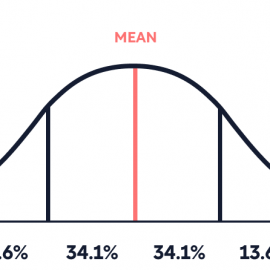

This article is an excerpt from the Shortform book guide to "The Great Mental Models Volume 1" by Shane Parrish and Rhiannon Beaubien. Shortform has the world's best summaries and analyses of books you should be reading.
Like this article? Sign up for a free trial here.
Can you train yourself to think in probabilities? How can this mental model help you make better decisions?
In The Great Mental Models Volume 1, Shane Parrish and Rhiannon Beaubien explain how estimating probabilities can narrow down decisions. They discuss three types of probabilistic thinking: Bayesian thinking, fat-tailed curves, and asymmetries.
Keep reading to learn how probabilistic thinking can help you navigate difficult decisions.
Consider the Chances
Considering the chances helps you determine which possibilities are most likely to happen. That is, the authors recommend using probability techniques to explore the most likely consequences of any decision. By determining the probabilities of various outcomes, you can avoid choices that are likely to turn out poorly.
According to the authors, we don’t naturally think in terms of probabilities. To equip you with this mental model, they explain three key forms of probabilistic thinking:
#1: Bayesian thinking: Put simply, Bayesian thinking involves evaluating new information in light of what you already know and being willing to update your beliefs when new and compelling information comes along. When practiced consistently, updating what you know keeps you from holding onto outdated ideas—which are more likely to be wrong. (Shortform note: While the authors present a plain language distillation of Bayesian thinking, Bayes’ theorem can be expressed as a mathematical formula. With uses in probability and prediction, Bayesian thinking is valuable to fields such as machine learning and stock trading.)
#2: Fat-tailed curves: Some domains, such as running speed, fit a bell curve (a normal distribution). Others, like finance, fit fat-tailed curves—that is, they’re more prone to extreme outlier events like financial crashes or geopolitical clashes. Know when you’re operating in a fat-tailed domain so you can plan for extreme events. (Shortform note: Fat-tailed curves are the underlying focus of Nassim Nicholas Taleb’s work in Fooled By Randomness, The Black Swan, and Antifragile. Antifragility, for example, is his proposed response to the fact that massively impactful events are impossible to predict: Since they happen, but we can’t know when, you should prepare yourself to adapt and benefit from disruptions of all types.)
#3: Asymmetries: The authors say that we often overestimate how accurate our probability estimates are. To avoid this, remember that you’re biased to think highly of yourself, and regularly scrutinize your thinking. (Shortform note: In finance, asymmetries have a different meaning. For instance, Tony Robbins recommends in Money: Master the Game that you look for asymmetric risk/reward in investing—opportunities to earn big while risking little.)

———End of Preview———
Like what you just read? Read the rest of the world's best book summary and analysis of Shane Parrish and Rhiannon Beaubien's "The Great Mental Models Volume 1" at Shortform.
Here's what you'll find in our full The Great Mental Models Volume 1 summary:
- What mental models are and how they work
- How to make better decisions by using mental models
- How to use your imagination to evaluate your choices






